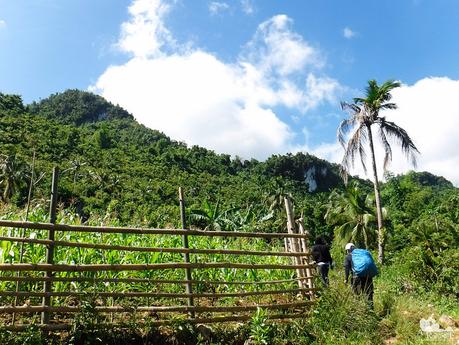
Unlike other tall mountains in the country, Cebu’s mountains do not have obvious prominence. However, punch-for-punch, our peaks do not lack in the way of adventure. The mountain range that stretches along the entire island’s length provides a unique opportunity for those who want to really challenge themselves. Answering to the call of the challenge and upon the invitation of our friend Wella, we joined her team in climbing three mountains in Toledo, Cebu.
Wild Mt. Makatol, towering Puting Bato, and grassy Mt. KM 28 constituted the Toledo trilogy due to their proximity to each other. As experienced as we were, climbing two mountains and one monolith in the span of two days will definitely test our endurance.
Mount Makatol
After a short briefing, we started trekking towards the foot of Mt. Makatol. The hot morning extracted large rivulets of sweat from our bodies as we walked. We passed through the rough backroads of a large community before we had a clear sight of the mountain’s western face.
The dense forest cover meant that Mt. Makatol is rarely climbed. The carpet of green is broken only by the two visible white limestone cliffs that cleaved its face.
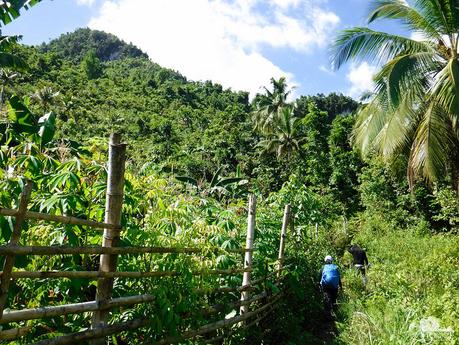
The ascent began almost immediately after we left the farm trail we were walking on. The forest cover began abruptly, and the entire team fought through the wild, healthy foliage. The lead local guide used his sharp bolo to hack a barely discernible trail for the rest of the team.
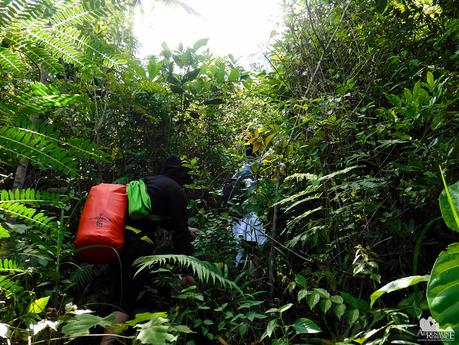
The trail was not constant. At some points, the ascent is gradual; but in some, it’s quite steep. But one thing is for sure—the foliage was extremely thick. In fact, the density of the foliage made it difficult to sustain a comfortable pace, which Sweetie and I are comfortable with. We had to constantly wrestle with vines and branches that entangled our packs, clothes, and limbs.
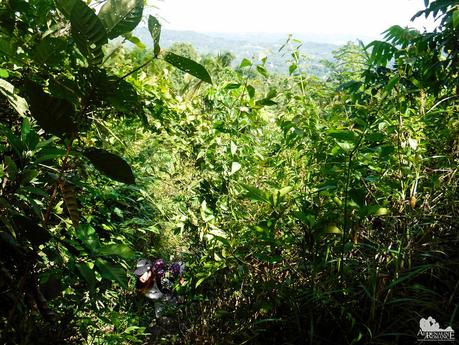
In the Visayan language, “makatol” means itchy. And Mt. Makatol lived up to its name in more ways than one. The plants here have weapons to fight us! Some are covered with menacing spike-like thorns that can pierce cloth and skin easily. Others are covered with tiny hair-like structures that, when embedded in the skin, cause severe itching. And others have leaf blades which are wickedly sharp. No matter how careful we were, everyone in the team got “souvenirs” in the form of puncture wounds, cuts, and rashes.
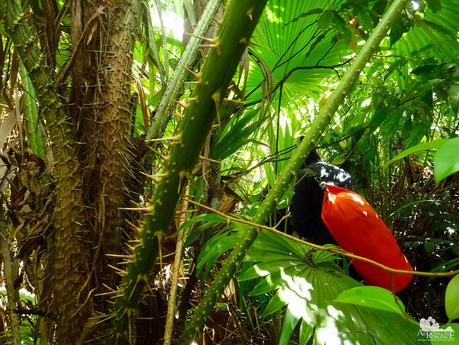
While navigating through the prickly vegetation, we sensed that the guide has a deja vu; he has a vague sense of knowing there to go as if the way was imprinted in the recesses of his mind. When we brought this to him, he explained that there was once a woodcutter’s trail many years ago. But the slippery rocks made the trail quite dangerous, especially for woodcutters carrying a full load on their shoulders. They abandoned the path and established an easier, safer one which terminated somewhere in the middle of Mt. Makatol.
Therefore, we had the honor of being the first people who walked on and rediscovered on an old, disused trail that was once an economic and social lifeline for the village far below us.
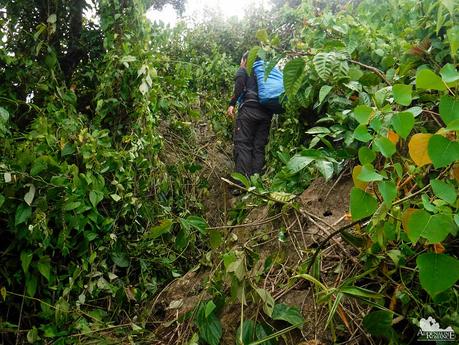
Soon, we understood why the local woodcutters do not go this way. It was filled to the brim with loose, steep, razor sharp rocks that can easily injure a careless person. As if that is not enough, the rocks become very slippery when it rains.
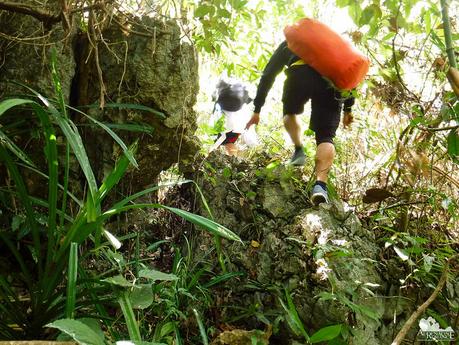
One of the highlights—and most dangerous—parts of the trail is a 10-foot, 90-degree wall which needs to be ascended. Rotting and loose rocks make the holds and footholds brittle, which meant that we had to be very careful where to apply our force and weight. We can’t rely on the branches and roots as well because many of them are just dead husks.

Getting up the boulder-strewn trail required some helping hands and teamwork. Also, note the foliage-covered ground. Those roots, branches, and leaves cover deep holes and crevices.
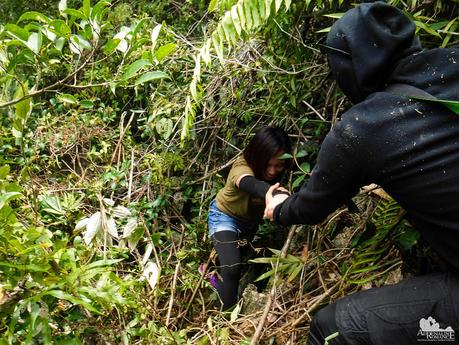
Despite the short but taxing nature of the climb, we were not a group who would quit easily. Thus, after 3 hours of scrambling up sharp boulders and wrestling through thick vines and whipping branches, we finally arrived at the rocky summit of Mt. Makatol.
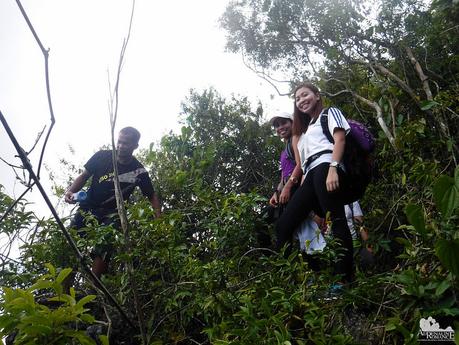
Our exhausted guides perched themselves on natural alcoves that Mother Nature carved on Mt. Makatol’s summit. The way they positioned themselves made us feel jittery; there was nothing below their feet but a deep abyss that is covered by flimsy branches which couldn’t hold the weight of a person. A misstep forward then—well, you know what happens.
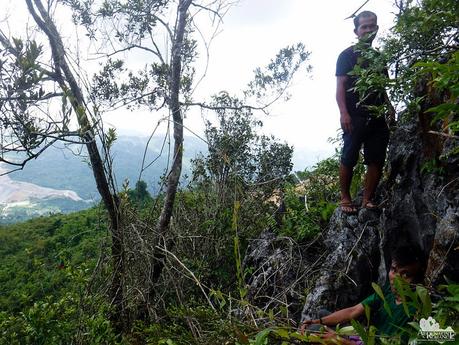
But the summit did offer a beautiful view of the small but township of Lutopan and the enormous scar that is the Atlas Mining Corporation’s open-mine pit. Up here, the vista constitutes an interesting contrast. Many parts of Cebu’s highlands are still rich in green forest cover despite centuries of massive deforestation. Highland towns like Lutopan show that nature, culture, and development can coexist harmoniously. But to continue our way of modern living—or because of sheer greed—Mother Nature must often give way, usually resulting in a swath of horrible destruction.
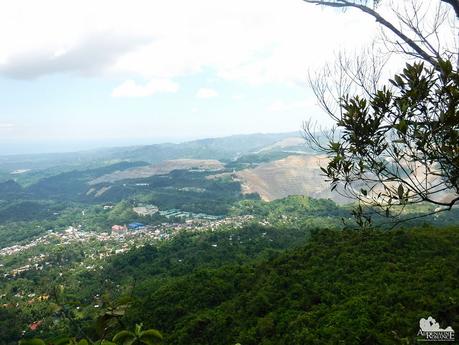
Healthy moss and lichen decorate the rocks that make up Mt. Makatol’s summit. They are homes to insects, mollusks, and other small mountain creatures. They hold a lot of moisture, which makes them good water reservoirs.
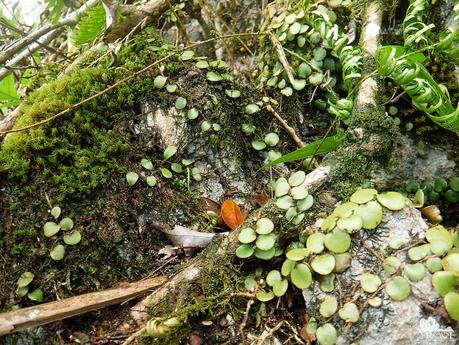
While eating our packed lunch, Sweetie and I became quite uneasy when we spotted dark, gloomy clouds on the horizon. A distant peal of thunder, a sudden drop in temperature, and a heavy-moisture laden breeze were sure signs of rain coming in. While we are used to walking in the rain, getting off the mountain would be difficult, especially for the novice trekkers in the group. Wet rock is very slippery, and in the mountains, an accidental slip can cause injury.
One of the guides, Sweetie, and I decided to go down first so we could check out the rock conditions and widen the trail. Our guide suggested that we trailblaze a bit until we will arrive at a relatively easy trail that woodcutters presently use. His plan merited a go-signal from us.
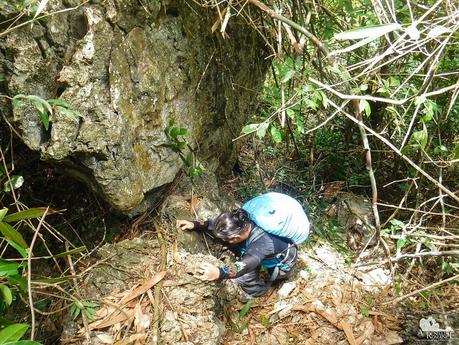
We tried to hasten our pace, but a moderate rain overtook us. Thankfully, it lasted less than an hour; and by the time we reached the woodcutter’s trail, the sun shone through the clouds again.
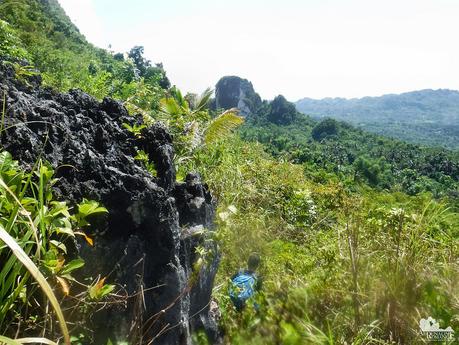
We could see the immense monolith of Puting Bato/Bantogan Banog less than a kilometer away. Our plan was to climb the monolith following a short rest when we exit Mt. Makatol. However, climbing the wet rocks of Puting Bato/Bantogan Banog would be unsafe. For safety reasons, we decided to abort the climb and reschedule it the next day.
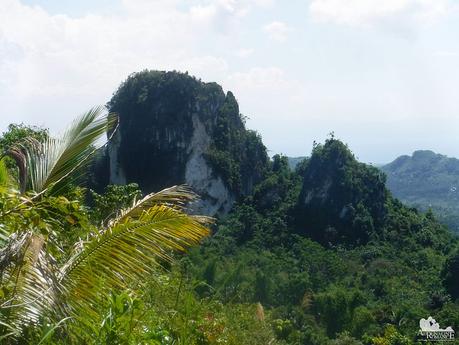
Large limestone outcroppings dot Mt. Makatol’s slope, jutting out of the plant cover. We will have to come back here to see if they are suitable for bouldering.

Look at that verdant slope! Looking up Mt. Makatol from this vantage invoked a mesmerizing feeling, knowing that we just hacked for hours through those woods which concealed a treacherous rocky trail.
Most importantly, the thick and pristine forest that covers the mountain gave us a sense of hope and renewal. As long as the forest is not abused, Mt. Makatol will remain an alluring mountain that dutifully watches over Toledo.
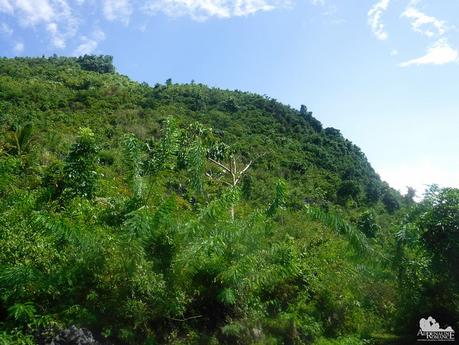
After a short rest, we continued down the farm trail towards the edge of the barangay under Mt. Makatol’s shadow. Having accomplished the first mountain in the Toledo trilogy, we celebrated our safe return by gulping double bottles of ice-cold Sparkle.
Goodbye, Mt. Makatol. Thank you for deeming us worthy to step on your challenging slope.
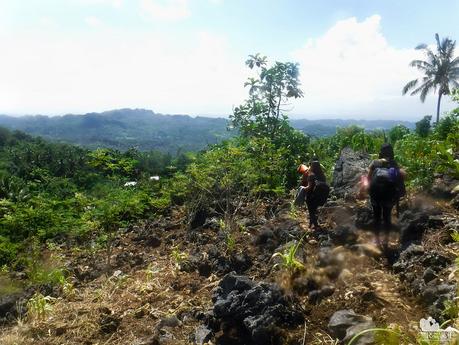
Mt. KM 28
The harsh glare of the afternoon sun began to soften, and the mountain air emitted a hint of chill. It was the perfect time to start the ascent on the second mountain, the picturesque Mt. KM 28. Technically, the mountain is in Minglanilla; but because it is actually more accessible from Lutopan, we decided to include it in the Toledo trio.
With the weather becoming more pleasant by the minute, we started our ascent. It has been several months since we last climbed Mt. KM 28, but the mountain is as scenic as ever. In the distance, we silently enjoyed a vista that resembles the pine forest of Marlboro Country in Mt. Pulag. Tall limestone karst cliffs peeked through the green cover.
Since we already climbed this mountain a few months ago, we won’t write a lengthy post. Check out our earlier blog post for full details about climbing Mt. KM 28.
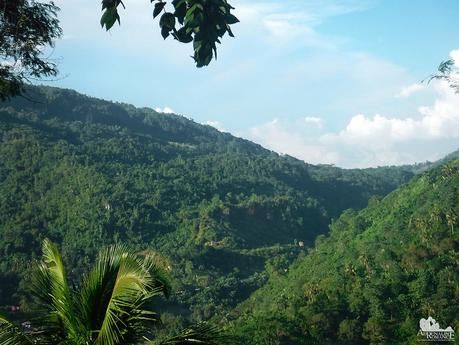
Your mind is programmed to keep you in the safe zone. So if you want to live your life to the fullest, you need to get off your lazy butt and leave that safe zone. You have to defy your limitations. You have to inject passion and drive in your life.
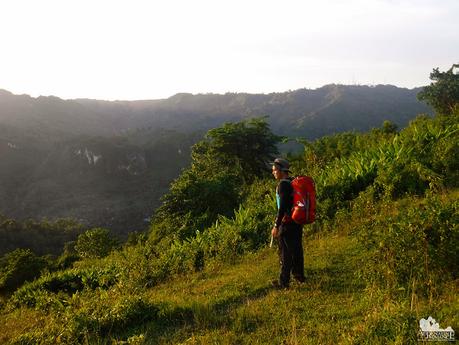
Like a dazzling sunset, the end of something isn’t always dark, ugly, and hopeless. In fact, in many instances, the end is beautiful. It signals a new hope, a refresher, a new chapter of life.
Kicked out of a job? That’s a gateway for new opportunities. Hurt over a devastating breakup? It’s a chance for you to meet a special someone. Feeling the despair over a massive failure? It’s a call for you that it’s not over. It’s a call that you’re coming back; and you’ll be better, stronger, and more determined than ever before.
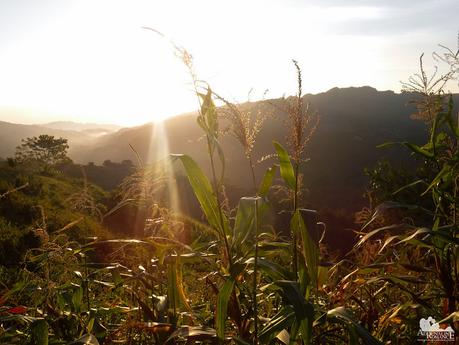
We were already quite exhausted from our earlier climb up Mt. Makatol, but we still managed to reach the summit after two hours of trekking over the hills and expansive farmlands. We pitched our tents, cooked our dinner, and slept while the rest of the team had their socials. By the way, do you know that if you spend a week camping outdoors, your body clock will reset to its natural sleep rhythms?
The early bird gets the worm. Since we slept early, Sweetie and I also woke up early, just in time to see a unique pink and blue sunrise. Such wonders!
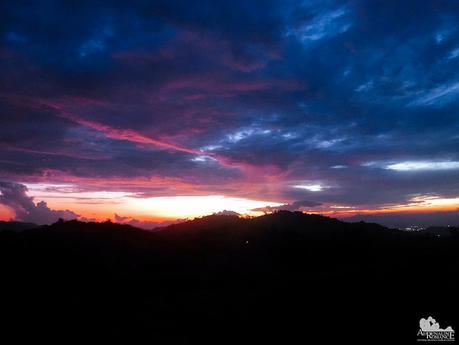
We prepared a hot breakfast and broke camp quickly before the sun burns the campsite. At around 8 AM, we left Mt. KM 28 and trekked across the highland barangay of Kalbasaan towards the DENR man-made forest in Camp 7. Of course, the lovely scenery of hills, farms, and mountains made all those rivers of sweat and screams of muscle pain worth it.
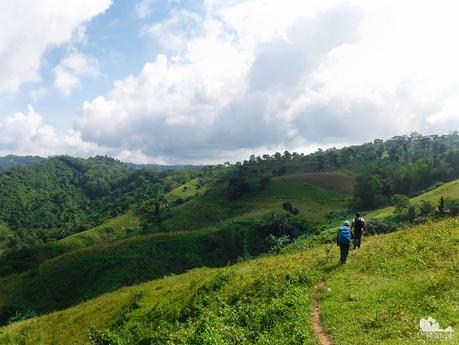
Feeling rejuvenated after a downing a bottle of ice-cold Coke, we breezed through the mountain and into the woods. In less than two hours, we exited the man-made forest where we rested for a while before proceeding to town to have a snack of cold, sweet gulaman (jelly). It was BASO who introduced us to this snack, and we were totally hooked to it!
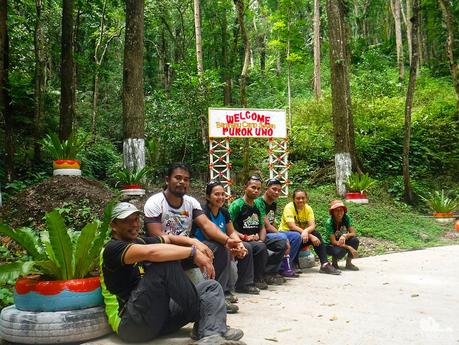
Puting Bato/Bantogan Banog
Capping off the trilogy is a climb to the top of Puting Bato/Bantogan Banog, a gigantic monolith that overlooks the town of Lutopan like a silent guardian.
Looking at the pristine limestone wall and the foliage-covered top invoked happy memories of our first climb here.
Since we already climbed this monolith, we won’t write a lengthy post. Check out our earlier blog post for full details about climbing Puting Bato/Bantogan Banog.
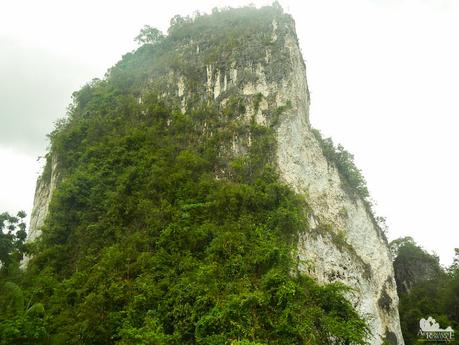
It also made us miss rock climbing; we haven’t climbed for two months now due to bad weather.
We asked our guide Enie if they have plans to bolt the rock for sport climbing. Not at the present time, unfortunately. He explained that the lower half of the cliff is replete of handholds and footholds. Thus, Puting Bato/Bantogan Banog is not beginner-friendly and can only be climbed by strong, experienced climbers who want to push themselves.
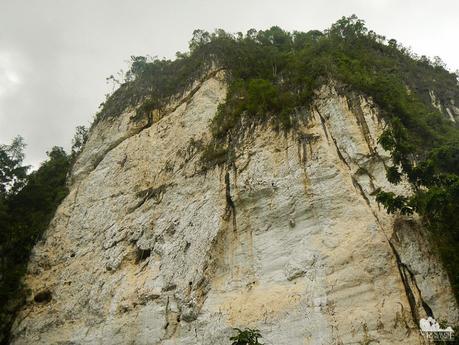
Only a few people climb the monolith, usually just local kids hunting for birds and daring lovers who want to have some only-the-two-of-us time. Thus, the foliage here is quite heavy, partly covering a rocky trail.
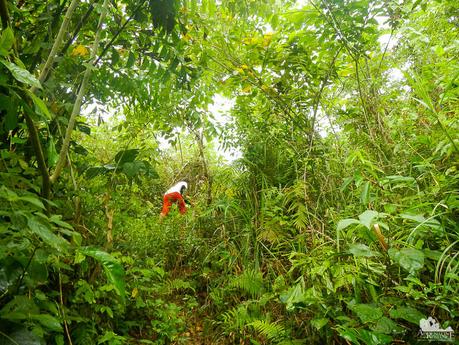
Climbing the vertical rock face of Puting Bato/Bantogan Banog requires extreme caution even though the climb itself is just around 15 minutes. The rocks are loose, constantly cleaved by wind and water erosion. The handholds and footholds are small. Scrambling up the cliff when raining is hazardous.
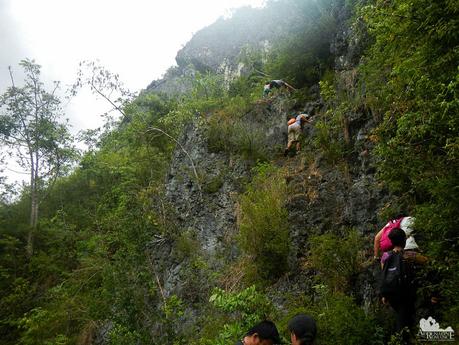
The scenery all around Puting Bato/Bantogan Banog’s viewing deck is stunning.
Climbing Puting Bato is similar to overcoming a perception of fear and failure. Many times in your life, you believe that you could not overcome a seemingly insurmountable barrier. You might feel that you could not stand up from a massive failure.
But surprisingly, it often involves a bit of effort—just a “do-it-before-you-whine” attitude—to be triumphant. Once you succeed, you will realize that you wouldn’t be where you are now if you didn’t take that first step. You wouldn’t be here if you didn’t embrace the effort and responsibility.
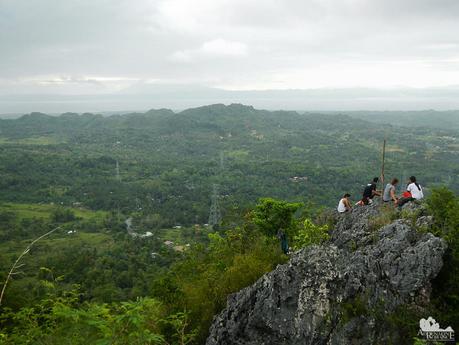
The rocky summit is just a little above the viewing deck. Be careful when ascending here as it involves skipping over rocks and crevices.
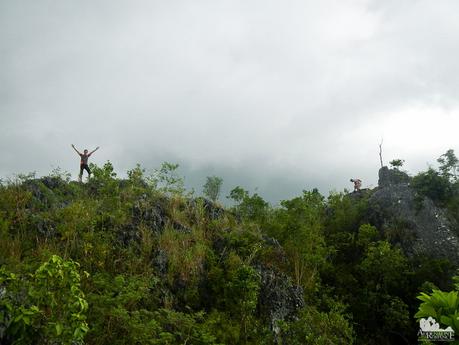
Across Puting Bato is Mt. Makatol, with its unspoiled green cloak. We believe in the spirit of the mountain, and it seems to beckon us to come.
We have utmost respect and constant admiration for all mountains we climbed. We take into heart the lessons they teach us. As such, in the eyes of Mother Nature, we may have earned from her a warm, safe, and grand welcome in every adventure we take.
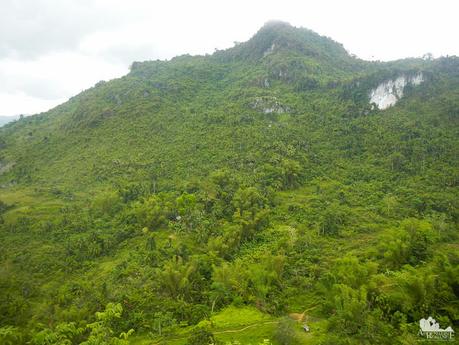
Special Thanks
We would like to thank Wella Osilao for inviting us for this tri-mountain climb. Your team is a joy to be with in the outdoors. And of course, the adventure was absolutely fun!
We would also like to thank our product partner Se7en Outdoors for our ultra-sleek and cool dry-fit shirts. For comfortable, tough, and quality outdoor apparel, check out Se7en Outdoors.
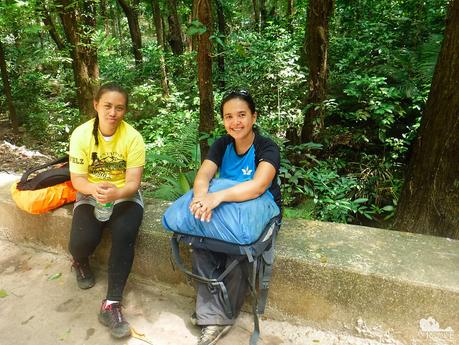
Itinerary
Day 1
6:00 AM – depart from Cebu South Bus Terminal, bus trip to Landing, Lutopan
7:30 AM – arrival at Landing Lutopan, breakfast, last-minute purchases, briefing
9:00 AM – start trek to Mt. Makatol
12:00 PM – reach summit of Mt. Makatol, eat lunch
1:00 PM – start descent from Mt. Makatol
2:30 PM – completion of Mt. Makatol climb, break
4:00 PM – ride habal-habal to KM 28 jump-off
4:30 PM – start trek to Mt. KM 28 campsite
7:00 PM – arrival at Mt. KM 28 campsite, pitch tent, cook dinner
8:00 PM – dinner, socials
10:00 PM – Lights Off
Day 2
5:30 AM – wake up, prepare breakfast
6:30 AM – breakfast, picture taking, break camp
8:00 AM – start descent from Mt. KM 28 via Kalbasaan
10:00 AM – exit DENR Man-made forest, mid-morning snack at Camp 7
10:30 AM – ride habal-habal to Landing and DAS Village
11:00 AM – start trek to Puting Bato/Bantogan Banog
11:45 AM – reach summit of Puting Bato/Bantogan Banog, picture taking, lunch
12:30 PM – get down from Puting Bato/Bantogan Banog, trek back to DAS Village
1:00 PM – reach DAS Village, refresh, short rest
1:30 PM – ride bus back to Cebu
Recommended Itineraries
We ditched climbing Puting Bato/Bantogan Banog on Day 1 due to rainy weather. For a more logistically efficient schedule (at the price of a more exhausting trio-climb), we recommend the following itinerary:
- Day 1 AM – climb Mt. Makatol and Puting Bato
- Day 1 PM – climb Mt. KM 28
- Day 2 AM – exit Mt. KM 28
For an easier, less tiring trio-climb, we recommend the itinerary below:
- Day 1 PM – climb Mt. KM 28
- Day 2 AM – climb Mt. Makatol and Puting Bato
Budget*
- P 40 per person – bus fare from Cebu South Bus Terminal to Landing, Lutopan (same rate applies on the return trip)
- P 20 per person – habal-habal fare from Landing to Camp 8/ Mt. Km 28 jump-off
- P 30 per person – habal-habal fare from Camp 7 to Landing
- TBN- guide fee
* We did not include our expenses for snacks, tips, and other fees in this rate sheet as you may have different needs, preferences, itineraries, and sharing scheme from us. Note that all figures are subject to change without prior notice.
Tips
1. For guideship services, please contact Wella Anito Osilao at 0915-511-9823 or 0918-271-0117. You can also email her at [email protected]. She can help you find a guide there. Alternatively, you can also get in touch with the BASO Outdoor Club for assistance.
2. This is a perfect adventure for cash-strapped adventurers. As you can probably infer from the estimated budget above, this trek is pretty cheap. You’ll probably spend more on drinks and snacks than the actual essentials of the trip itself.
3. Climbing 2 mountains and a monolith in two days is not something to be taken lightly. Make sure you prepare yourself by exercising, eating right, and fueling yourself before your climb.
4. The rocks of Mt. Makatol and Puting Bato are sharp, treacherous, and slippery when wet. Be extra careful when walking or climbing on these rocks.
5. Don’t forget to bring a wide-brimmed hat, scarf, or umbrella to protect yourself from the heat. Don’t hesitate to tell the guide to stop if you feel exhausted.
6. Wear arm guards and trekking pants to protect your skin from the sun and prickly plants. We also recommend wearing gloves.
7. Wear trekking shoes or sandals with an aggressive tread. You will need a lot of traction since you will be scrambling over loose soil and slippery rocks.
8. Bring salt tablets or ion-filled beverages such as Gatorade, coconut water, or fruit juice aside from water. The hot sun, multiple ascents, and exposed trails can make you sweat a lot. When you lose enough ions and salts via your sweat, cramps will occur. If cramps happen, rest for awhile, drink a lot of water or ionic drinks. This will replenish the ions in your system. Bring energy-rich trail food such as nuts, crackers, bread, and bananas.
9. Pack light but do bring the following:
- water (at least 3 liters)
- good-quality 3-season tent with fly sheet and ground sheet
- cookset (can be shared with the group)
- burner (can be shared with the group)
- arm guards
- cold weather gear (warmer, thermal underwear, fleece jacket, windbreaker)
- extra clothes (1 set for climbing, 1 set for sleeping, 1 set for returning home)
- trekking shoes
- light flip-flops (for walking around the campsite)
- raincoat, rain jacket, or poncho
- hat, scarf, and sunglasses (to protect yourself from the sun)
- first aid kit
- food for dinner and breakfast
- hydration salts, table salt, or Gatorade (to avoid and relieve cramps)
- toiletries and sunblock
- toilet paper (for cleaning your cooking utensils)
- headlamp or flashlight
- extra money
- trail snack
10. Don’t forget to waterproof your belongings. You can do this easily by wrapping your stuff inside dry sacks or dry bags.
11. Please mind your trash; do not leave any of your garbage behind.

